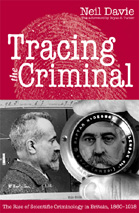 |

Sample Chapter (pdf) |
Tracing the Criminal January 2006, hardback, 304pp NO LONGER AVAILABLE Tracing the Criminal recounts the history of the emergence of 'scientific' criminology in Britain during the period 1860-1918. It shows how it developed from the prevalent view that criminals constituted a sub-category of the Human Race who differed from the law-abiding majority in other ways than simply by their lawbreaking, and that those differences were accessible to scientific investigation. As a result, the criminal was increasingly seen as a genetic threat to the wider population. Neil Davie's perceptive study explores the ideas and research of this era and examines the impact of the influential theories of Lombroso, Galton, Goring and others. As Professor Davie makes clear, the new inductive science of criminology sought not merely to describe criminals, but also to explain them. What gripped the minds of a wide range of Victorians and Edwardians was thus not simply a taxonomic desire to pin a label on 'The Criminal' and place him or her under a bell jar, but the urge to explore the very springs of crime itself. This is a mind-reader of a book. Neil Davie has identified the major puzzles
facing criminological historians, providing answers in clear, lively prose.
Zooming right in on the key theoretical issues, he presents persuasive arguments
that are sure to change the direction of the field. This is a most welcome book,
one that readers on both sides of the Atlantic will want to add to their personal
libraries. |
Email: info@bardwell-press.co.uk Tel.: 01865 865 865 Fax: 01865 595 598